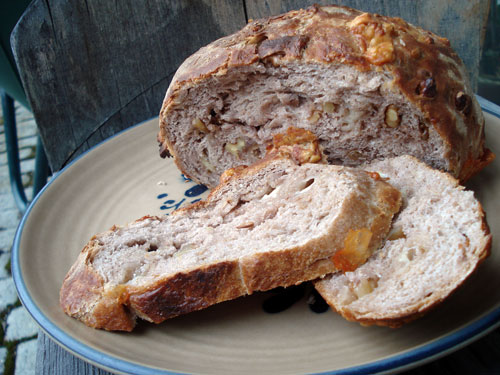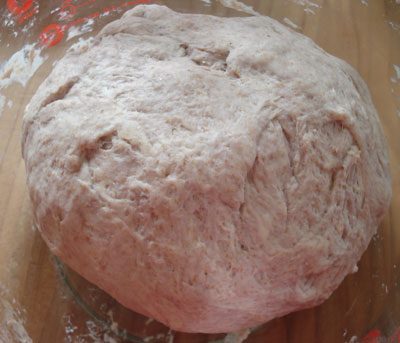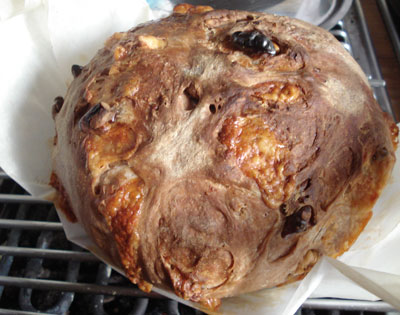Wine, cheese and walnut whole wheat bread using the Almost No-Knead method

More than a year ago, a method of making bread that required no kneading at all was published in the New York Times, and swept through the food blogging world like wildfire. Here is that original recipe (login required). I tried it too, and while it did produce a very nice loaf, I found it rather lacking in character. So I adapted the method for making desem bread, a natural-yeast (no yeast added) bread that has a wonderful flavor.
However, desem is a very labor-intensive bread, even if the loaves themselves are made the no-knead way. The desem starter itself has to be nurtured and fed continuously. I haven't managed to keep one alive for more than a few months at a time - when I get too busy, or go away or something, the desem dies and I have to start over. (I've tried freezing it and things and the results have been rather mixed.)
Late last year, Cook's Illustrated came out with a recipe they called Almost No-Knead Bread. Some people have taken to calling it No-Knead 2.0, but the original is called Almost No-Knead. Here's a link to the recipe that doesn't require registration, though if they close that loophole you can register there for 14 days for free. I haven't seen Almost No-Knead rage through the food blogging world with quite the enthusiasm that the original No-Knead did, but it is an interesting development. There is some minimal kneading involved, but nothing too taxing.
Here are the key differences between the No-Knead and the Almost No-Knead methods:
- Beer (lager) and a little vinegar are added to Almost No-Knead, to add some character and flavor. (One of the main criticisms of Original No-Knead was that the bread was a bit bland.)
- Almost No-Knead is less hydrated. No-Knead calls for 1 5/8 cups of water per 3 cups of flour, and Almost calls for 1 1/4 cups of liquid in the form of 3/4 cups + 2 tablespoons of water and 1/4 cup + 2 tablespoons of lager. This allows for easier handling of the dough.
- Almost No-Knead requires a little kneading and shaping of the loaf before the second rise.
- An innovation added by Almost No-Knead is a sort of sling made of kitchen parchment paper, which is put under the loaf with the ends hanging out of the cast iron pot the loaf is baked in. This allows for the load to be taken out of that red hot pot easily.
I find that the No-Knead method produces a slightly better, more crackly crust, probably due to the higher hydration. But the taste of Almost No-Knead is indeed better, more tangy and complex, though not as deeply complex as a true sourdough. Both have that sort of silky, slightly doughy, open and moist texture that is much desired in 'artisanal' type breads.
Everyday Almost No-Knead
I've tried the original Almost No-Knead as well as the variations (I did buy a 1-year subscription to Cook's Illustrated by the way, it is worth while) such as Seeded Rye and Pecan and Cranberries. The latter one is really good.
The schedule for making the bread that fits our daily life goes like this: I mix up the bread late in the evening, around 10 or 11. It requires an 18 hour rise, but it's not too picky in that regard - an hour less or more doesn't seem to affect things too much. The next day, around 5 or 6 whenever someone gets home if we are out, it's punched down and kneaded (I like to add the additives at this stage rather than at the start) and given a 2 hour rise, then baked. We have the bread for dinner or for breakfast, or both. If you only have time to bake on weekends, do the bread mixing on Saturday to have fresh baked bread on Sunday, counting back at least 22 hours (1/2 hour for mixing/kneading, 18 for the first rise, 2 for the second rise, and 1 1/2 hours for cooling and such) from when you want to eat the bread.
Taking it even further
After I'd made the lager and vinegar flavored loaves several times, I started to wonder if adding wine would work. I used to love a bread called baguette au vin et rosette, pictured here, a crusty and hearty baguette with bits of rosette sausage and wine actually in the dough. The baker who made it unfortunately sold up and moved on, so I can't get that bread anymore. After several tries, I think I have hit upon a combination that really works. So after a long preamble, here's the recipe. Note that the hydration (amount of water) is a bit different from the original Almost No-Knead.
Recipe: Almost No-Knead whole wheat wine bread with walnuts and cheese
- 2 cups (10 oz / 280g) all-purpose flour
- 1 cup (5 oz / 140g) whole wheat flour
- 1/4 to 1/3 tsp. dry yeast
- 1 1/2 tsp. salt
- 3/4 cups (177ml) lukewarm water
- 1/4 cup dry red wine
- 3/4 cups of roughly chopped walnuts
- 1/2 cup finely diced aged Gruyère, or other aged hard cheese
In a bowl, mix together the flours, yeast and salt. (Note about the yeast: I really don't know what rapid-rise yeast is in German, and there's only one kind of dry yeast sold here commonly, so I add just a tad more of that, and it works fine.) Add the liquids and mix until it forms a shaggy ball. It looks like this - the red wine does make it a light purple in color, but after it's baked it's much less noticeable (as you can see in the top photo).

Cover the ball and let it rise in a warm place for about 18 hours. (The most reliably warm place in our house is on top of an old PC tower case, turned on of course.)
After 18 hours or so are up, the dough should be risen and puffy. Knead in the walnuts and cheese, and form a ball again. Make a sort of sling out of parchment paper, but cutting a length of it off and folding it into half or thirds. Set this under the ball, in a pot or skillet, and cover the whole thing with a large bowl turned upside down over it, or plastic film. You may want to consult the step by step illustrations on the Cook's Illustrated site for this part, or the video.)
Set your timer to 90 minutes, and when it beeps put an enamelled cast-iron pot in the oven and set it to 500°F / 260°C, or a bit less than that if you have a convection oven. (I do, and I set it to 250°C.) Set your timer to 30 minutes.
Take out the red-hot pot carefully, take the dough by the sling, and drop it in the pot. Bake for about 30 minutes, and take off the lid; if it looks too pale for you at this point, bake for an additional 10 minutes or so.
When done, take the bread out using the sling, and let cool on a rack. (My cooling rack is my grill!)

The wine really makes this bread taste interesting. A slice of this plus a salad or soup makes for a very satisfying lunch, and it also makes a great sandwich.
Variations
You can leave out the cheese for a walnut bread, or use pecans instead. Chopped up black olives are nice too, instead of the cheese. Or leave all out for a plain wine bread which goes well with just about anything, but especially - you guessed it - cheese.
One addition that has not worked for me so far is adding ham or sausage, a la the baguette au vin et rosette. Whatever ham or sausage I've tried has made the bread turn overly sausage-y. The experimentation on that front continues.
If you enjoyed this article, please consider becoming my patron via Patreon. ^_^

 Welcome to Just Hungry, where we serve authentic Japanese recipes and more! I'm
Welcome to Just Hungry, where we serve authentic Japanese recipes and more! I'm 













Comments
yoko
8 April, 2008 - 16:01
Permalink
I’m eagerly awaiting my
I'm eagerly awaiting my first issue for Cook's Illustrated!
Adding beer or wine to the bread sounds intriguing. I may need to give that a try.
andreea
8 April, 2008 - 16:04
Permalink
what if i were to leave the
what if i were to leave the cheese our and have a slice of cheese on top instead? :)
this looks absolutely delicious!
maki
8 April, 2008 - 20:29
Permalink
Adding cheese to the bread
Adding cheese to the bread gives it a sort of burnt flavor (the crust is really yummy with it) which is addictive. You could top the slices with cheese of course. Or go nuts and do both! :)
Tom
8 April, 2008 - 19:11
Permalink
Bread in a Pot
Your bread looks great. I too have been experimenting with baking in a cast-iron pot with great results. I've been interested in this baking method since reading about it in Peter Berley's book, The Modern Vegetarian Kitchen published in 2000. I bought the book when it was new. I bought the cast-iron pot just last month! I guess I got sidetracked for the past eight years.
Kevin
9 April, 2008 - 04:39
Permalink
That bread sounds good and
That bread sounds good and looks great!
anon.
9 April, 2008 - 05:02
Permalink
I’ve been using the method
I've been using the method from Artisan Bread in 5 Minutes a Day, and it has worked really well for me. Great crust and crumb, and the dough keeps for a couple weeks (developing a natural sourdough flavor as it goes).
maki
9 April, 2008 - 08:35
Permalink
Cook's Illustrated
I should clarify that I got the online subscription to Cook's Illustrated, not for the printed magazine - didn't want to pay for the international postage for that. The online sub is worth it I think, since they have a ton of good recipes and tutorials and videos behnd the pay wall. And it costs the same wherever you are in the world!
We Are Never Full
13 April, 2008 - 19:14
Permalink
Wow… this recipe looks
Wow... this recipe looks delicious. Absolutely mouth-watering. I actually canceled my subscription to Cooks Illustrated only because it just wasn't inspiring me anymore. But, this recipe may have made me change my mind! Great post. Love the blog.
amy @ We Are Never Full
Kiriel
25 April, 2008 - 02:27
Permalink
No knead bread
I have just posted up a recipe for an almost no knead bread - a sort of pain paillasse... its just great to have a recipe you can make so far in advance, so you can have fresh bread when you want it.
Found your website through Columbus foodie's list of foodblogs, and thought I should say hi, as a fellow food blogger in Switzerland!
maki
25 April, 2008 - 10:49
Permalink
bread
Hi Kiriel! Always great to hear from another Swiss food blogger. Your bread looks great - I'll have to give it a try!
Loretta
23 October, 2011 - 10:16
Permalink
Re: Wine, cheese and walnut whole wheat bread using the ...
I was so impressed with another blogger's 3 day yudane milk bread that I looked at more of the recipes. I'm now completely besotted with her(?) version of the Lahey no-knead method (I didn't have an oven in 2007 or 2008 and missed the craze).
http://m.xuite.net/#/blog/jane7443/bake/15336926
Like you she chose wine
I make it by mixing together
210g White bread flour
45g wholemeal bread flour
45g rye flour
50ml red wine (but I've been using a gifted screw top Grenache)
205ml water
Just over 1/8 teaspoon instant yeast
Generous 1 teaspoon salt
This week I'll be buying LOADS of organic wholewheat flour and following your epic desem journey (I think am ready now and will use my trusty bread-machine/mochi maker to do the 800 strokes the original recipe calls for)